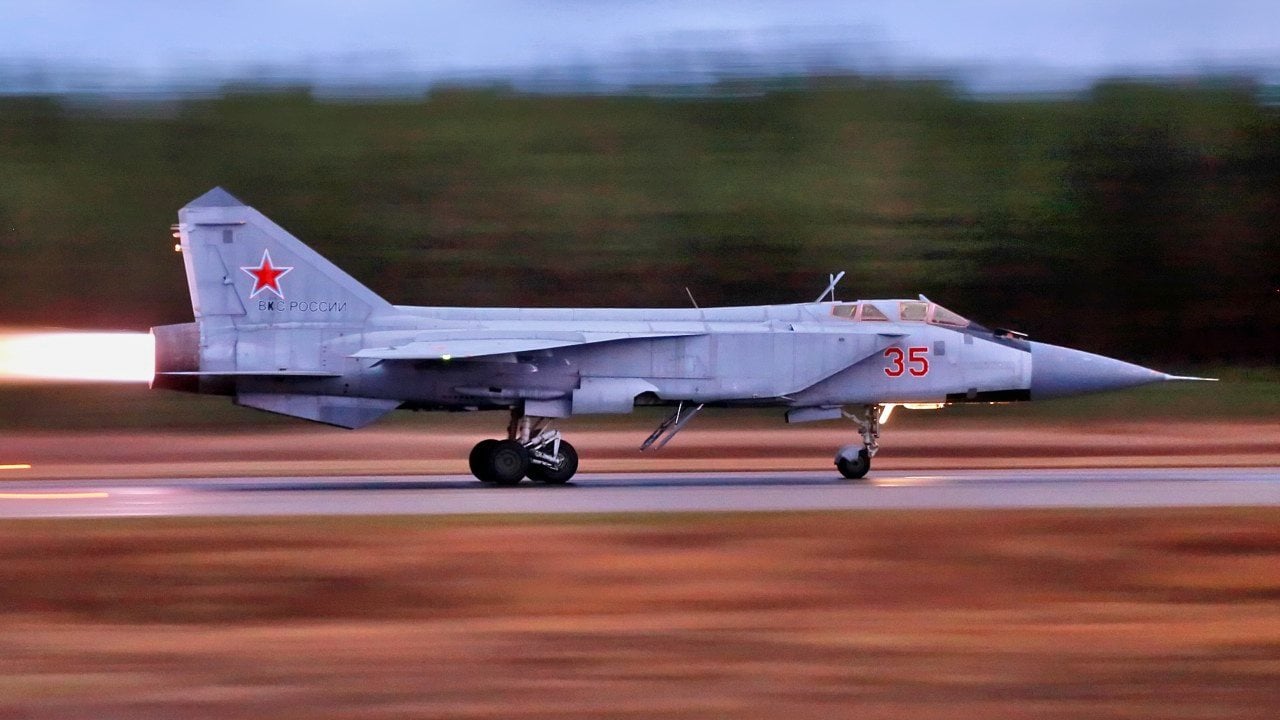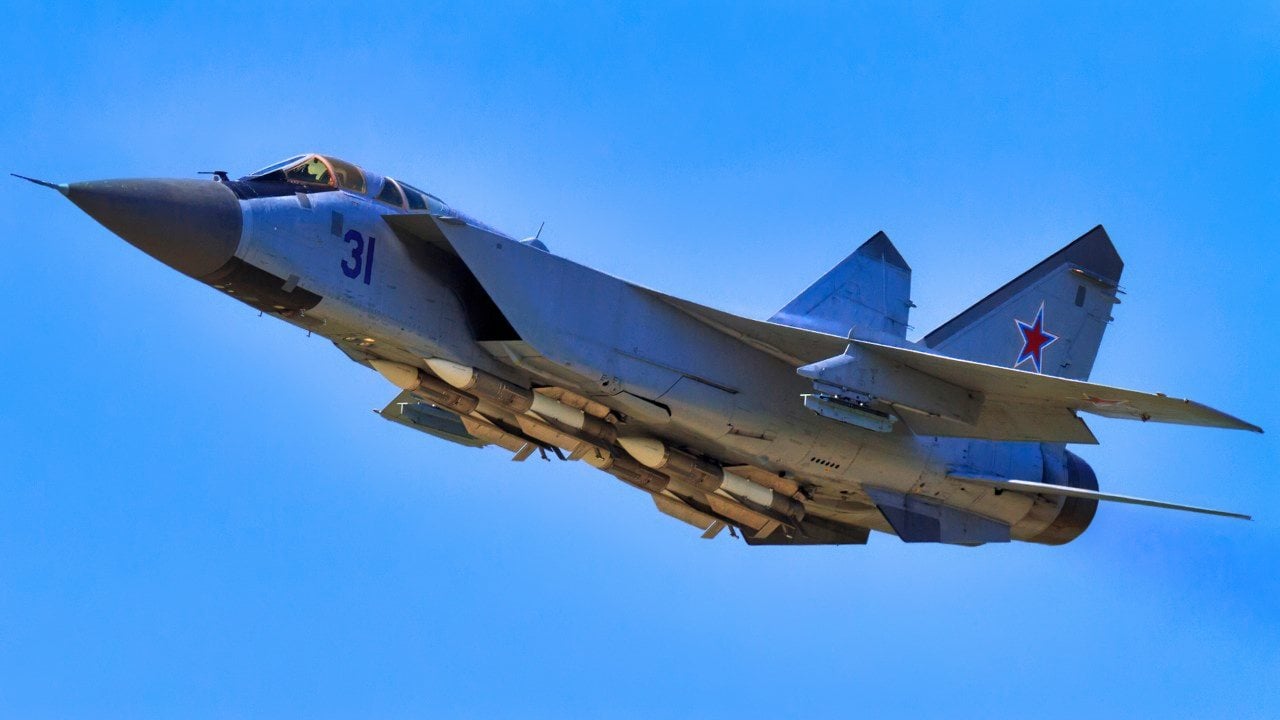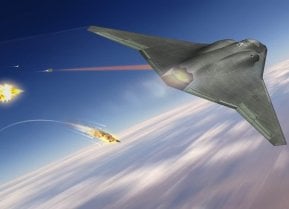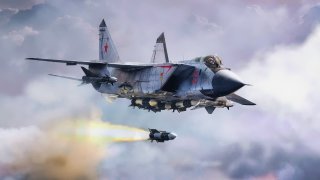MiG-31: Russia's Mach 2 Fighter That Broke All the Rules
The MiG-31 "Foxhound," developed from the MiG-25 "Foxbat," entered service in 1981 as an advanced Soviet interceptor. While retaining the MiG-25's high-speed capabilities, the MiG-31 introduced significant improvements, including look-down/shoot-down radar, enhanced avionics, and extended range, enabling it to cover greater distances with aerial refueling.
Summary and Key Points: The MiG-31 "Foxhound," developed from the MiG-25 "Foxbat," entered service in 1981 as an advanced Soviet interceptor. While retaining the MiG-25's high-speed capabilities, the MiG-31 introduced significant improvements, including look-down/shoot-down radar, enhanced avionics, and extended range, enabling it to cover greater distances with aerial refueling.

-The Foxhound also featured improved communication and networking capabilities, allowing better coordination during missions.
-Despite limited export success, the MiG-31 remains active in Russia's military, having been used in missions over Syria and Ukraine. The aircraft is equipped with various air-to-air missiles and a GSh-6-23 cannon.
MiG-31 Foxhound: Russia's High-Speed Interceptor with a Deadly Edge
When the MiG-25 “Foxbat” entered service with the Soviet Union in 1970, it gave NATO airpower planners plenty to worry about. The Foxbat was the fastest interceptor in the world at the time, and the ever-pervasive fear of the unknown flew alongside it. However, much of that fear dissipated after the defection of MiG-25 pilot Lt. Viktor Belenko in 1976. Belenko helped to eliminate the aura of mystery that had surrounded this high-speed aircraft.
But the Soviet war machine didn’t let Belenko’s defection deter them from improving on the concept. Thus the MiG-31 “Foxhound” was born.
From Foxbat to MiG-31Foxhound
The Foxhound made her maiden flight in September 1975 and officially entered into service with the Soviet PVO (voyska protivovozdushnoy oborony, or Anti-Air Defense Troops) in 1981.
The MiG-31 bears a striking cosmetic resemblance to the MiG-25, which probably explains at least in part why NATO retained the “Fox” portion when assigning its codename to the successor aircraft. However, look beneath the surface and you will find the Foxhound equipped with state-of-the-art digital avionics that its older foxy sibling lacked.
For one thing, the MiG-31 was the first Soviet fighter aircraft to have true look-down/shoot-down capability, thanks to its phased array radar. Earlier USSR fighter radars had a tendency to run afoul of ground clutter. In addition, the Foxhound can work efficiently in all weather conditions while fulfilling visual flight rules and instrument flight rules, day and night.
Yet another improvement was the newer plane’s extended range, which increased to 1,900 miles (3,000 kilometers) upon initial takeoff, and further bolstered to 3,400 miles (5,400 kilometers) with one aerial refueling. By contrast, the gas-guzzling Foxbat bore the curse of a relatively short range: 1,160 miles (1,860 kilometers) at Mach 0.9 and 1,013 miles (1,630 kilometers) when zipping along at Mach 2.35. This underscored how lucky the aforementioned Belenko was to make his initial escape from Vladivostok to Hokkaido, Japan. (In retrospect, perhaps NATO should’ve codenamed the MiG-25 the “Cheetah.” It can pursue its prey at tremendous speeds, but only for short distances.)

The Foxhound’s pilots also enjoyed a reduced likelihood of “failure to communicate.” As my colleague Caleb Larson explains, "MiG-31s can network with other airplanes in their sortie, relaying information on enemy aircraft locations and thus covering a much wider area than unnetworked groups of airplanes."
Foxhound Flies On
Five hundred and nineteen Foxhounds have been produced so far, out of which 370 were delivered to the Russian Air Force and 30 are in service with Kazakh air force. In July 2020, Russia’s Defense Ministry announced its intention to invest in modernization and life extension programs for its MiG-31 fleet.
MiG-31 customers outside of the former Soviet republics have been few and far between. In 1992, right on the heels of the collapse of the Soviet Union, the cash-starved post-Soviet Russian arms industry offered the Mig-31 to Finland, but the Finns turned it down. Meanwhile, Syria ordered eight MiG-31E airframes for its own air force in 2007, but the order was suspended in May 2007. Six of these MiGs may or not have been delivered to Syria as of August 2015, depending on whether you choose to believe the Turkish or the Russian media.
What is not in dispute is that the Russians themselves have deployed the MiG-31 in missions over Syria. In addition, the Foxhound has been “blooded” in Vladimir Putin‘s so-called special military operation in Ukraine. On March 18, 2023, a MiG-31K variant launched a strike on a Ukrainian arms depot near the Polish border, evidently using a Kh-47M2 Kinzhal hypersonic missile. In turn, on April 26, the Ukrainians managed to shoot down a Foxhound with a British-made Starstreak missile.
MiG-31 - Specifications
General Characteristics
Crew: Two (pilot and weapons system officer)
Length: 22.69 m (74 ft 5 in)
Wingspan: 13.46 m (44 ft 2 in)
Height: 6.15 m (20 ft 2 in)
Wing area: 61.6 m² (663 ft²)
Empty weight: 21,820 kg (48,100 lb)
- Loaded weight: 41,000 kg (90,400 lb)
- Max. takeoff weight: 46,200 kg (101,900 lb)
- Powerplant: 2 × Soloviev D-30F6 afterburning turbofans
- Dry thrust: 93 kN (20,900 lbf) each
- Thrust with afterburner: 152 kN (34,172 lbf) each
Armament
1× GSh-6-23 23 mm cannon with 260 rounds.
Fuselage recesses for 4× R-33 (AA-9 ‘Amos’) (or for MiG-31M/BM only 6× R-37 (AA-X-13 ‘Arrow’) long-range air-to-air missiles)
4 underwing pylons for a combination of:
- 2× R-40TD1 (AA-6 ‘Acrid’) medium-range missiles, and[Clarification needed]
- 4× R-60 (AA-8 ‘Aphid’)
- 4× R-73 (AA-11 ‘Archer’) short-range IR missiles,
- 4× R-77 (AA-12 ‘Adder’) medium-range missiles
About the Author
Christian D. Orr is a former Air Force officer, Federal law enforcement officer, and private military contractor (with assignments worked in Iraq, the United Arab Emirates, Kosovo, Japan, Germany, and the Pentagon). Chris holds a B.A. in International Relations from the University of Southern California (USC) and an M.A. in Intelligence Studies (concentration in Terrorism Studies) from American Military University (AMU). He has also been published in The Daily Torch and The Journal of Intelligence and Cyber Security.
All images are Creative Commons.


